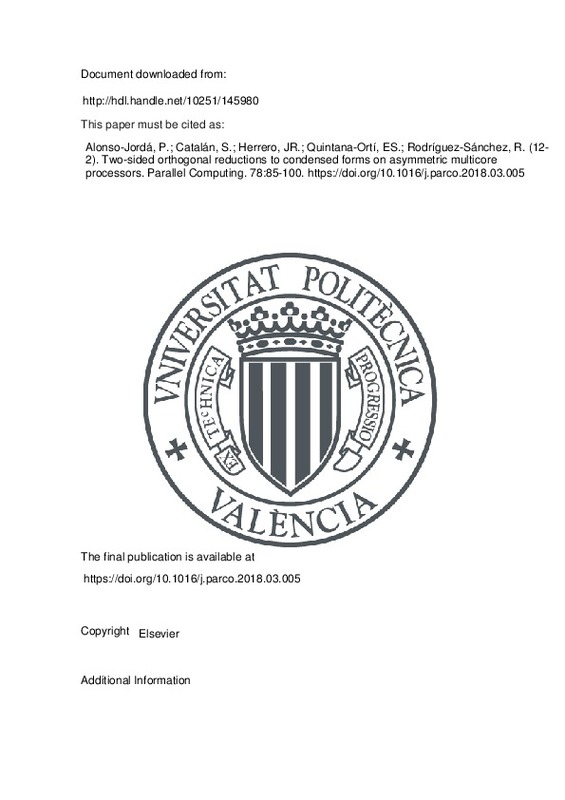Alonso-Jordá, P.; Catalán, S.; Herrero, JR.; Quintana-Ortí, ES.; Rodríguez-Sánchez, R. (2018). Two-sided orthogonal reductions to condensed forms on asymmetric multicore processors. Parallel Computing. 78:85-100. https://doi.org/10.1016/j.parco.2018.03.005
Por favor, use este identificador para citar o enlazar este ítem: http://hdl.handle.net/10251/145980
|
Título:
|
Two-sided orthogonal reductions to condensed forms on asymmetric multicore processors
|
|
Autor:
|

 Alonso-Jordá, Pedro
Catalán, Sandra
Herrero, José R.
Alonso-Jordá, Pedro
Catalán, Sandra
Herrero, José R.

 Quintana-Ortí, Enrique Salvador
Rodríguez-Sánchez, Rafael
Quintana-Ortí, Enrique Salvador
Rodríguez-Sánchez, Rafael
|
|
Entidad UPV:
|
Universitat Politècnica de València. Departamento de Informática de Sistemas y Computadores - Departament d'Informàtica de Sistemes i Computadors
Universitat Politècnica de València. Departamento de Sistemas Informáticos y Computación - Departament de Sistemes Informàtics i Computació
|
|
Fecha difusión:
|
|
|
Resumen:
|
[EN] We investigate how to leverage the heterogeneous resources of an Asymmetric Multicore Processor (AMP) in order to deliver high performance in the reduction to condensed forms for the solution of dense eigenvalue and ...[+]
[EN] We investigate how to leverage the heterogeneous resources of an Asymmetric Multicore Processor (AMP) in order to deliver high performance in the reduction to condensed forms for the solution of dense eigenvalue and singular-value problems. The routines that realize this type of two-sided orthogonal reductions (TSOR) in LAPACK are especially challenging, since a significant fraction of their floating-point operations are cast in terms of memory-bound kernels while the remaining part corresponds to efficient compute-bound kernels. To deal with this scenario: (1) we leverage implementations of memory-bound and compute-bound kernels specifically tuned for AMPs; (2) we select the algorithmic block size for the TSOR routines via a practical model; and (3) we adjust the type and number of cores to use at each step of the reduction. Our experiments validate the model and assess the performance of our asymmetry-aware TSOR routines, using an ARMv7 big.LITTLE AMP, for three key operations: the reduction to tridiagonal form for symmetric eigenvalue problems, the reduction to Hessenberg form for non-symmetric eigenvalue problems, and the reduction to bidiagonal form for singular-value problems.
[-]
|
|
Palabras clave:
|
Dense linear algebra
,
Condensed forms
,
Eigenvalue problems
,
Singular-value problems
,
Asymmetric multicore processors
,
Heterogeneous computing
,
Multi-threading
,
Workload balancing
|
|
Derechos de uso:
|
Reconocimiento - No comercial - Sin obra derivada (by-nc-nd)
|
|
Fuente:
|
Parallel Computing. (issn:
0167-8191
)
|
|
DOI:
|
10.1016/j.parco.2018.03.005
|
|
Editorial:
|
Elsevier
|
|
Versión del editor:
|
https://doi.org/10.1016/j.parco.2018.03.005
|
|
Título del congreso:
|
International Workshop on Programming Models and Applications for Multicores and Manycores (PMAM 2017)
|
|
Lugar del congreso:
|
Austin, Texas, USA
|
|
Fecha congreso:
|
Febrero 04-08,2017
|
|
Código del Proyecto:
|
info:eu-repo/grantAgreement/MINECO//TIN2015-65316-P/ES/COMPUTACION DE ALTAS PRESTACIONES VII/
info:eu-repo/grantAgreement/MINECO//TIN2014-53495-R/ES/COMPUTACION HETEROGENEA DE BAJO CONSUMO/
info:eu-repo/grantAgreement/GC//2014 SGR 1051/
info:eu-repo/grantAgreement/GV//PROMETEOII/2014/003/
|
|
Agradecimientos:
|
The researchers from Universidad Jaume I were supported by project TIN2014-53495-R of MINECO and FEDER, and the FPU program of MECD. The researcher from Universitat Politecnica de Valencia was supported by the Generalitat ...[+]
The researchers from Universidad Jaume I were supported by project TIN2014-53495-R of MINECO and FEDER, and the FPU program of MECD. The researcher from Universitat Politecnica de Valencia was supported by the Generalitat Valenciana PROMETEOII/2014/003. The researcher from Universitat Politecnica de Catalunya was supported by projects TIN2015-65316-P from the Spanish Ministry of Education and 2014 SGR 1051 from the Generalitat de Catalunya, Dep. d'Innovacio, Universitats i Empresa.
[-]
|
|
Tipo:
|
Artículo
Comunicación en congreso
|







![[Cerrado]](/themes/UPV/images/candado.png)


